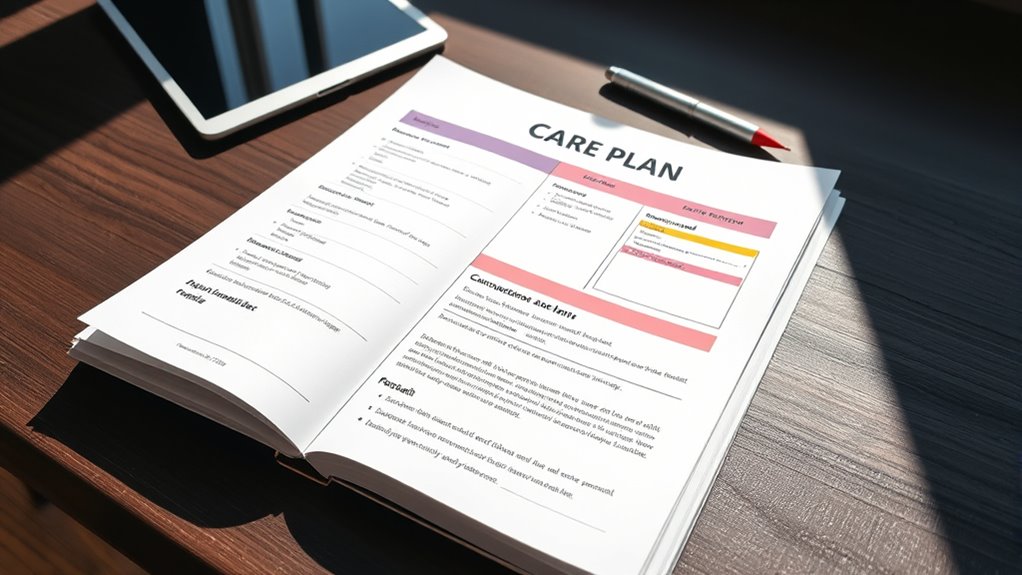Care plan templates and examples help you organize patient care efficiently by providing clear, standardized sections for assessments, diagnoses, goals, interventions, and evaluations. They promote consistency, improve documentation quality, and support better communication among your healthcare team. Using these tools guarantees thorough, legal, and safe care delivery while allowing quick customization for each patient’s needs. Keep exploring to discover effective tips and sample templates that can enhance your care planning process even further.
Key Takeaways
- Sample care plan templates typically include sections for assessments, diagnoses, goals, interventions, and evaluations.
- Examples demonstrate how to customize templates for various patient conditions and individual needs.
- Templates often feature prompts or checklists to ensure comprehensive and standardized documentation.
- Well-designed care plans promote consistency, improve communication, and support quality assurance in patient care.
- Access to diverse examples helps healthcare providers develop effective, organized, and adaptable care planning tools.

Are you looking for an efficient way to organize and track patient care? Using care plan templates can considerably streamline your workflow, guaranteeing that you provide consistent, high-quality care while maintaining compliance with healthcare regulations. These templates serve as a structured framework, guiding you through essential aspects of patient management and helping you document each step thoroughly. One of the primary advantages of care plan templates is their ability to enhance patient safety. When you follow a standardized format, you reduce the risk of missing essential information, which can lead to errors or oversights that compromise care. Templates also promote adherence to documentation standards, guaranteeing that your records are clear, complete, and easily understandable for everyone involved in the patient’s treatment. This consistency is critical for effective communication among healthcare providers and for legal and billing purposes.
Utilizing care plan templates allows you to quickly customize plans for individual patients while still maintaining the core structure that supports patient safety. You can incorporate relevant clinical data, goals, interventions, and evaluations in a systematic way. This helps you track progress over time and identify any areas that need adjustment, fostering a proactive approach to patient care. When templates are designed with best practices in mind, they also encourage thorough documentation, which is essential not only for quality assurance but also for legal protection. Accurate, standardized records minimize ambiguity and ensure that anyone reviewing the patient’s history can understand the care provided and the rationale behind specific interventions.
Moreover, care plan templates can serve as training tools for new staff, helping them learn your facility’s documentation standards and patient safety protocols more efficiently. They act as a checklist to guarantee all critical elements are addressed each time, reducing variability in care delivery. This consistency supports better patient outcomes and improves overall safety standards within your team. When choosing or designing a care plan template, look for features that promote clarity and ease of use, such as clearly labeled sections for assessments, diagnoses, goals, interventions, and evaluations. Incorporating prompts or checklists can also guide you to include all necessary information while adhering to documentation standards. Additionally, understanding the importance of standardized processes like those seen in large organizations such as WWE Raw can inspire best practices in creating reliable and effective care plans.
Frequently Asked Questions
How Often Should a Care Plan Be Reviewed and Updated?
You should review and update the care plan regularly, typically every three to six months, to guarantee it stays relevant. The review schedule depends on the care recipient’s changing needs or significant events. If there are any health changes or new goals, update the care plan immediately. Regular reviews help you stay proactive, track progress, and adapt strategies, making sure the care plan continues to meet the individual’s needs effectively.
Can Care Plan Templates Be Customized for Specific Conditions?
Yes, you can customize care plan templates for specific conditions. Many templates offer personalization options, allowing you to tailor assessments, goals, and interventions to individual needs. The template flexibility makes it easier to adapt plans for different health issues or patient circumstances. By customizing, you guarantee that each care plan accurately reflects the unique requirements of the patient, leading to more effective and personalized care delivery.
What Are Common Mistakes to Avoid When Creating a Care Plan?
Avoid common mistakes by focusing on clear, realistic goals, ensuring patient involvement, and maintaining interdisciplinary coordination. Don’t overlook individual needs, skip detailed assessments, or rely on vague strategies. Instead, tailor your plan to the patient’s unique circumstances, communicate effectively across teams, and update the plan regularly. Think of your care plan as a living document—flexible, precise, and centered on the patient’s progress and collaboration.
How Do I Measure the Effectiveness of a Care Plan?
To measure the effectiveness of a care plan, focus on outcome measurement and progress tracking. You should set clear, measurable goals and regularly evaluate whether the client is meeting them. Use specific indicators to track improvements or setbacks, adjusting the plan as needed. Consistent documentation helps you see patterns over time, ensuring the care plan remains effective and tailored to the client’s evolving needs.
Are There Legal Requirements for Documentation in Care Plans?
You need to dot your i’s and cross your t’s when it comes to legal compliance and documentation standards in care plans. There are indeed legal requirements, such as accurate, timely, and thorough records that demonstrate your care meets regulatory guidelines. Proper documentation not only protects you legally but also guarantees quality care. Always stay updated on local laws and facility policies to make sure your care plans are compliant and complete.
Conclusion
With these care plan templates and examples, you’ll be unstoppable—like a superhero armed with the ultimate toolkit. You’ll confidently craft personalized, effective plans that make a real difference. Remember, a well-organized care plan isn’t just a document; it’s the secret weapon to providing exceptional care. So, explore deeply, customize with ease, and watch your confidence soar higher than a rocket. Your clients will thank you for turning care into an art form!









